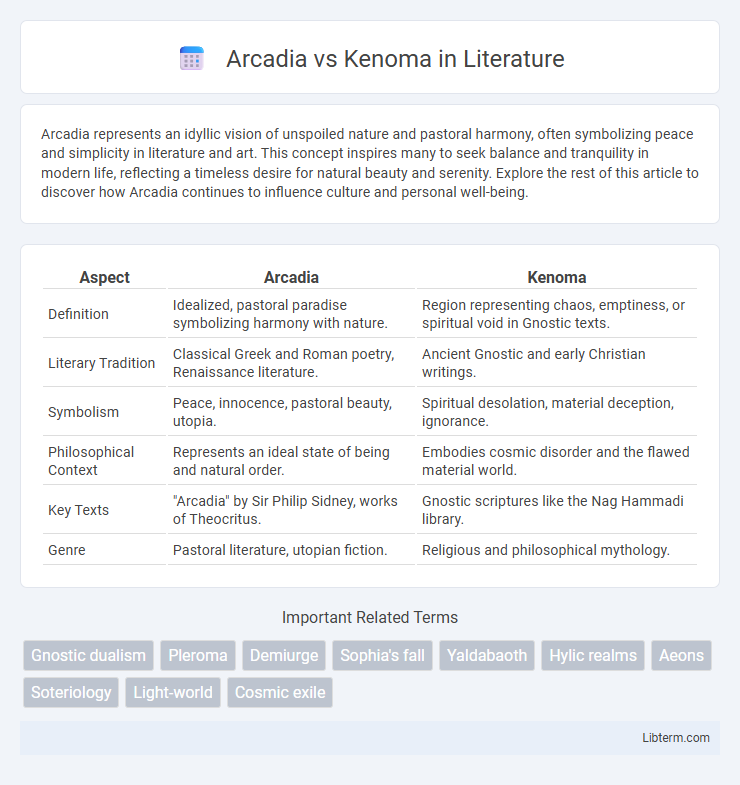Arcadia represents an idyllic vision of unspoiled nature and pastoral harmony, often symbolizing peace and simplicity in literature and art. This concept inspires many to seek balance and tranquility in modern life, reflecting a timeless desire for natural beauty and serenity. Explore the rest of this article to discover how Arcadia continues to influence culture and personal well-being.
Table of Comparison
| Aspect | Arcadia | Kenoma |
|---|---|---|
| Definition | Idealized, pastoral paradise symbolizing harmony with nature. | Region representing chaos, emptiness, or spiritual void in Gnostic texts. |
| Literary Tradition | Classical Greek and Roman poetry, Renaissance literature. | Ancient Gnostic and early Christian writings. |
| Symbolism | Peace, innocence, pastoral beauty, utopia. | Spiritual desolation, material deception, ignorance. |
| Philosophical Context | Represents an ideal state of being and natural order. | Embodies cosmic disorder and the flawed material world. |
| Key Texts | "Arcadia" by Sir Philip Sidney, works of Theocritus. | Gnostic scriptures like the Nag Hammadi library. |
| Genre | Pastoral literature, utopian fiction. | Religious and philosophical mythology. |
Introduction to Arcadia and Kenoma
Arcadia and Kenoma represent two distinct philosophical concepts rooted in ancient thought, with Arcadia symbolizing an idyllic, harmonious natural landscape often associated with pastoral simplicity and unspoiled beauty. Kenoma, in contrast, originates from Gnostic traditions, referring to the material world's emptiness or void, highlighting a realm of imperfection and spiritual desolation. Understanding these contrasting notions provides insight into the interplay between idealized nature and existential concepts in classical and esoteric philosophy.
Historical Origins of Arcadia and Kenoma
Arcadia, originating from ancient Greek mythology, represents an idealized, pastoral paradise symbolizing harmony with nature and simplicity in life. Kenoma, in contrast, stems from Gnostic traditions as a concept denoting the material world's emptiness or void, often linked to existential spiritual struggle. The historical origins of Arcadia are rooted in classical literature and art, while Kenoma is embedded in early Christian and Hellenistic religious thought emphasizing cosmic dualism.
Philosophical Interpretations
Arcadia symbolizes an idealized, harmonious utopia reflecting innocence and natural perfection, often associated with pastoral simplicity and existential peace. Kenoma, contrastingly, represents emptiness or void in Gnostic cosmology, highlighting themes of spiritual desolation and the flawed material world. Philosophically, Arcadia aligns with optimistic humanism and transcendence, while Kenoma embodies ontological estrangement and the quest for divine gnosis.
Symbolism in Literature
Arcadia symbolizes an idealized pastoral paradise representing harmony, innocence, and unspoiled nature in literature, often evoking nostalgia for a simpler, edenic world. Kenoma, by contrast, epitomizes a desolate, empty void reflecting chaos, suffering, and existential despair, commonly associated with the profane or material realm. The juxtaposition of Arcadia and Kenoma explores profound themes of spiritual transcendence versus worldly corruption, serving as powerful allegories in literary symbolism.
Religious and Mythological Contexts
Arcadia represents an idealized pastoral utopia in Greek mythology, embodying harmony with nature and the divine presence of gods like Pan. Kenoma, in Gnostic cosmology, signifies the material world's emptiness and imperfection, contrasting with the spiritual fullness or Pleroma. The religious symbolism of Arcadia evokes eternal peace and divine abundance, whereas Kenoma highlights the existential struggle between spiritual enlightenment and material bondage.
Arcadia: Ideals of Utopian Perfection
Arcadia represents an idyllic vision of utopian perfection characterized by harmonious coexistence with nature, unspoiled landscapes, and a peaceful pastoral lifestyle. This ideal emphasizes simplicity, innocence, and the pursuit of happiness through balance and tranquility, contrasting sharply with the chaotic, imperfect world often symbolized by Kenoma. Arcadia's enduring influence spans literature, art, and philosophy, reflecting humanity's longing for a perfect, serene sanctuary beyond worldly strife.
Kenoma: Emptiness and Cosmic Void
Kenoma, representing emptiness and the cosmic void in Gnostic cosmology, embodies the realm of deficiency and chaos, contrasting sharply with the harmonious fullness of Arcadia. This concept highlights the spiritual alienation and desolation experienced in Kenoma, where divine light is obscured by darkness and material illusion dominates. Kenoma's symbolism underscores the Gnostic pursuit of transcending the void to reclaim spiritual completeness and reunite with the Pleroma, the realm of divine fullness.
Arcadia vs Kenoma: Core Differences
Arcadia and Kenoma differ fundamentally in their conceptual frameworks and applications; Arcadia emphasizes a utopian, harmonious environment idealized in literature and philosophy, while Kenoma represents emptiness or void, often associated with Gnostic cosmology. Arcadia symbolizes abundance, peace, and natural beauty, reflecting an idealized pastoral existence. In contrast, Kenoma illustrates a realm of deficiency and material imperfection, highlighting the core metaphysical divergence between idealism and existential emptiness.
Influence on Modern Thought
Arcadia symbolizes an idealized pastoral paradise influencing Romanticism and environmental philosophy with its emphasis on harmony between humans and nature. Kenoma, representing emptiness or a world of deficiency in Gnostic cosmology, challenges material existence and inspires modern existential and metaphysical debates. The contrast between Arcadia's utopian vision and Kenoma's nihilistic void shapes contemporary discussions on spirituality, ethics, and ecological consciousness.
Conclusion: Relevance Today
Arcadia and Kenoma remain relevant today by symbolizing contrasting spiritual dimensions in Gnostic thought, with Arcadia representing a divine, perfected realm and Kenoma embodying the material world's emptiness and imperfection. Modern interpretations emphasize the psychological and existential significance of these concepts, reflecting humanity's search for meaning beyond physical existence. Their relevance persists in contemporary spirituality and philosophy, influencing discussions on transcendence and the duality of reality.
Arcadia Infographic

 libterm.com
libterm.com